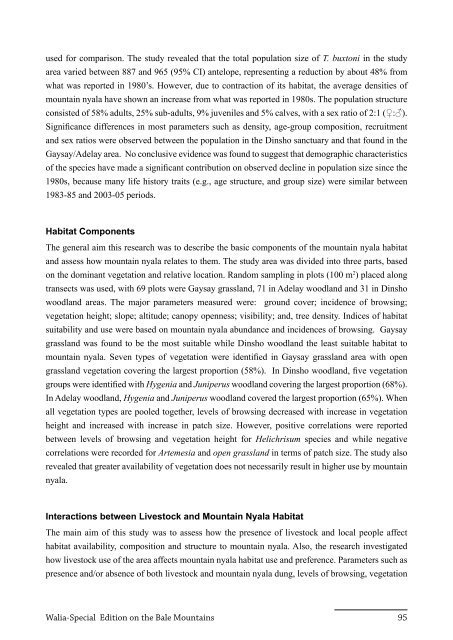Walia Special Edition on the Bale Mountains (2011) - Zoologische ...
Walia Special Edition on the Bale Mountains (2011) - Zoologische ...
Walia Special Edition on the Bale Mountains (2011) - Zoologische ...
You also want an ePaper? Increase the reach of your titles
YUMPU automatically turns print PDFs into web optimized ePapers that Google loves.
used for comparis<strong>on</strong>. The study revealed that <strong>the</strong> total populati<strong>on</strong> size of T. buxt<strong>on</strong>i in <strong>the</strong> study<br />
area varied between 887 and 965 (95% CI) antelope, representing a reducti<strong>on</strong> by about 48% from<br />
what was reported in 1980’s. However, due to c<strong>on</strong>tracti<strong>on</strong> of its habitat, <strong>the</strong> average densities of<br />
mountain nyala have shown an increase from what was reported in 1980s. The populati<strong>on</strong> structure<br />
c<strong>on</strong>sisted of 58% adults, 25% sub-adults, 9% juveniles and 5% calves, with a sex ratio of 2:1 (♀:♂).<br />
Significance differences in most parameters such as density, age-group compositi<strong>on</strong>, recruitment<br />
and sex ratios were observed between <strong>the</strong> populati<strong>on</strong> in <strong>the</strong> Dinsho sanctuary and that found in <strong>the</strong><br />
Gaysay/Adelay area. No c<strong>on</strong>clusive evidence was found to suggest that demographic characteristics<br />
of <strong>the</strong> species have made a significant c<strong>on</strong>tributi<strong>on</strong> <strong>on</strong> observed decline in populati<strong>on</strong> size since <strong>the</strong><br />
1980s, because many life history traits (e.g., age structure, and group size) were similar between<br />
1983-85 and 2003-05 periods.<br />
Habitat Comp<strong>on</strong>ents<br />
The general aim this research was to describe <strong>the</strong> basic comp<strong>on</strong>ents of <strong>the</strong> mountain nyala habitat<br />
and assess how mountain nyala relates to <strong>the</strong>m. The study area was divided into three parts, based<br />
<strong>on</strong> <strong>the</strong> dominant vegetati<strong>on</strong> and relative locati<strong>on</strong>. Random sampling in plots (100 m2 ) placed al<strong>on</strong>g<br />
transects was used, with 69 plots were Gaysay grassland, 71 in Adelay woodland and 31 in Dinsho<br />
woodland areas. The major parameters measured were: ground cover; incidence of browsing;<br />
vegetati<strong>on</strong> height; slope; altitude; canopy openness; visibility; and, tree density. Indices of habitat<br />
suitability and use were based <strong>on</strong> mountain nyala abundance and incidences of browsing. Gaysay<br />
grassland was found to be <strong>the</strong> most suitable while Dinsho woodland <strong>the</strong> least suitable habitat to<br />
mountain nyala. Seven types of vegetati<strong>on</strong> were identified in Gaysay grassland area with open<br />
grassland vegetati<strong>on</strong> covering <strong>the</strong> largest proporti<strong>on</strong> (58%). In Dinsho woodland, five vegetati<strong>on</strong><br />
groups were identified with Hygenia and Juniperus woodland covering <strong>the</strong> largest proporti<strong>on</strong> (68%).<br />
In Adelay woodland, Hygenia and Juniperus woodland covered <strong>the</strong> largest proporti<strong>on</strong> (65%). When<br />
all vegetati<strong>on</strong> types are pooled toge<strong>the</strong>r, levels of browsing decreased with increase in vegetati<strong>on</strong><br />
height and increased with increase in patch size. However, positive correlati<strong>on</strong>s were reported<br />
between levels of browsing and vegetati<strong>on</strong> height for Helichrisum species and while negative<br />
correlati<strong>on</strong>s were recorded for Artemesia and open grassland in terms of patch size. The study also<br />
revealed that greater availability of vegetati<strong>on</strong> does not necessarily result in higher use by mountain<br />
nyala.<br />
Interacti<strong>on</strong>s between Livestock and Mountain Nyala Habitat<br />
The main aim of this study was to assess how <strong>the</strong> presence of livestock and local people affect<br />
habitat availability, compositi<strong>on</strong> and structure to mountain nyala. Also, <strong>the</strong> research investigated<br />
how livestock use of <strong>the</strong> area affects mountain nyala habitat use and preference. Parameters such as<br />
presence and/or absence of both livestock and mountain nyala dung, levels of browsing, vegetati<strong>on</strong><br />
<str<strong>on</strong>g>Walia</str<strong>on</strong>g>-<str<strong>on</strong>g>Special</str<strong>on</strong>g> <str<strong>on</strong>g>Editi<strong>on</strong></str<strong>on</strong>g> <strong>on</strong> <strong>the</strong> <strong>Bale</strong> <strong>Mountains</strong> 95
















